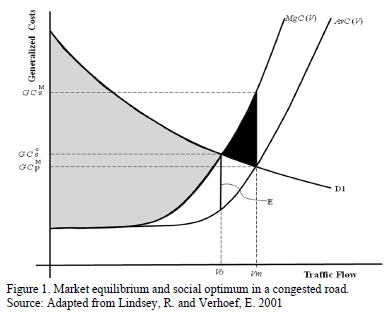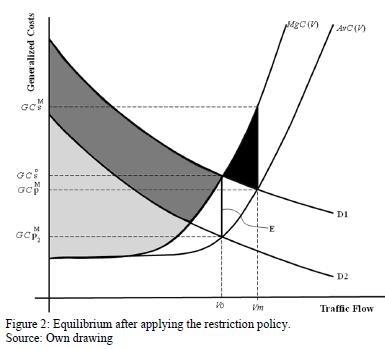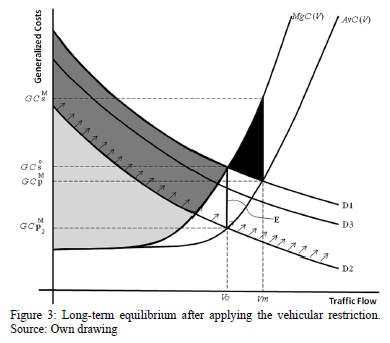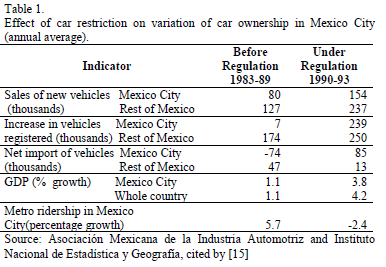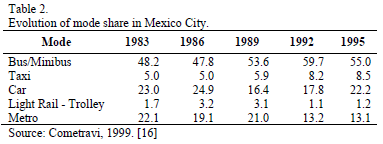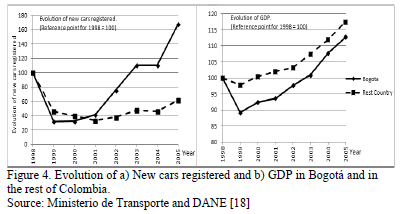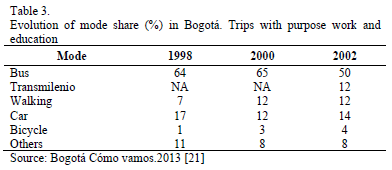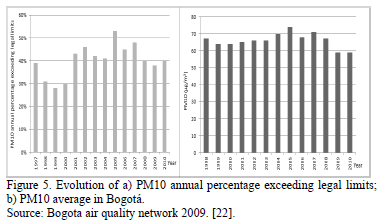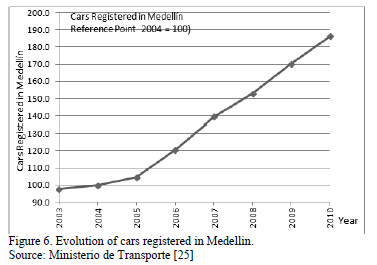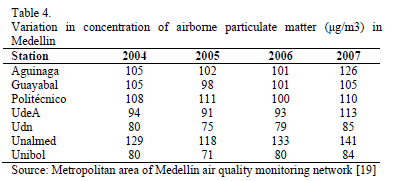Serviços Personalizados
Journal
Artigo
Indicadores
-
 Citado por SciELO
Citado por SciELO -
 Acessos
Acessos
Links relacionados
-
 Citado por Google
Citado por Google -
 Similares em
SciELO
Similares em
SciELO -
 Similares em Google
Similares em Google
Compartilhar
DYNA
versão impressa ISSN 0012-7353
Dyna rev.fac.nac.minas vol.81 no.188 Medellín nov./dez. 2014
https://doi.org/10.15446/dyna.v81n188.40081
http://dx.doi.org/10.15446/dyna.v81n188.40081
Restricting the use of cars by license plate numbers: A misguided urban transport policy
Restricción vehicular según número de patente: Una política de transporte errónea
Víctor Cantillo a & Juan de Dios Ortúzar b
a Department of Civil and Environmental Engineering, Universidad del Norte, Barranquilla, Colombia. vcantill@uninorte.edu.co
b Department of Transport Engineering and Logistics, Pontificia Universidad Católica de Chile, Santiago, Chile. jos@ing.puc.cl
Received: October 1th, 2013. Received in revised form: July 30th, 2014. Accepted: October 25th, 2014.
Abstract
Several conurbations in Latin America have implemented policies to restrict the use of private cars by prohibiting those with a license plate number ending on some digit, which vary each day, from circulating on that weekday. These policies have been formulated as a "second best" option to congestion charging as the latter policy has been deemed politically unfeasible so far. The idea underlying license plate restrictions is very simple: by not allowing a proportion of the total number of vehicles to circulate on a given day, congestion levels and other externalities are expected to decrease, improving the quality of life for people.
Based on a simple microeconomic analysis, supported by a review of the literature and by evidence collected in several cities where these restrictions have been implemented, it is concluded that the policy is apparently effective only in the very short-term, but ultimately it fails to achieve its objectives and usually leads to a worse outcome.
Keywords: Car restrictions; externalities; urban policies.
Resumen
Varias ciudades latinoamericanas han implementado políticas restrictivas al uso de vehículos particulares consistentes en prohibir su circulación según el número de su patente o placa. La política ha sido planteada como una alternativa de segunda mejor, al cargo por congestión; este último consiste en el cobro directo de la externalidad a los usuarios de vías congestionadas, pero es considerado políticamente inviable en la actualidad en muchos casos. La idea detrás de la restricción según patente es muy simple: al restringir una proporción del parque automotor se disminuye los niveles de congestión y otras externalidades negativas, especialmente las ambientales, mejorando la calidad de vida de las personas.
A través de un sencillo análisis microeconómico, apoyado en evidencia recogida en algunas ciudades donde se ha implementado esta política, se demuestra que sólo puede funcionar en el muy corto plazo y, finalmente, no logra el objetivo deseado en el largo plazo.
Palabras clave: Restricción vehicular; externalidades; políticas urbanas.
1. Introduction
Cities in the developing world have been experiencing a rapid increase in motorization. To deal with the growing congestion, smog, and other externalities associated with urban transport, it has become common for some conurbations in Latin America to restrict the use of private cars, by prohibiting vehicles with license plate numbers ending with certain pre-specified digits from circulating on certain days of the week. In Santiago de Chile, since 1986, vehicles lacking catalytic converters have been subject to this restriction during the autumn and winter periods. More recently, this restriction has also applied to vehicles with catalytic converters on emergency days [1]. In 1989, the government of Mexico City introduced the Hoy No Circula (which roughly translates as "Do Not Circulate Today") program, which bans drivers from using their cars on one day of the week also based on the last digit of the cars' license plate number; nowadays, a restriction is in force in the central zone of Mexico's metropolitan area, where 20% of all vehicles concentrate daily. In Colombia, Bogotá instituted the vehicular restriction known as Pico y Placa (which roughly translates as "Peak and Plate") in 1998. But, unlike the previous cities' restrictions, this measure was a response to traffic congestion and not to poor air quality [2]. The measure has been extended to other Colombian cities, including Medellín in 2005.
Outside Latin America, Manila has had a license plate number restriction in place for some time prohibiting certain vehicles from circulating on high traffic arteries during the rush hour [3]. An interesting case is the special odd-even license plate restriction that was used in Beijing during the 2008 Olympic Games where an evident reduction of congestion and mobile source pollution was confirmed during this period [4]. The benefits of such restriction seemed so attractive that authorities decided to resume it with a similar, but less restrictive, one-day-a-week licensing scheme, which stops 20% of private vehicles from using roads on weekdays.
According to local planners and politicians, the policy constitutes a second best alternative to congestion charging (which entails directly charging drivers using congested roads for a specific externality) [5], as any class of road pricing has been considered politically unfeasible so far. The virtues of this simple policy include its acceptance by large sectors of society, especially those who do not own cars (i.e. the majority of Latin Americans). Furthermore, as a result of the restriction it is expected that some drivers may experiment with using public transport and this is clearly a desirable effect.
Nevertheless, several disadvantages associated with this measure have also been identified, including the increase in automobile stock due to the fact that drivers with sufficient purchasing power tend to buy a second vehicle (often more polluting), the increase in the number of trips by taxi and motorbike, the risk of fraud inherent to the policy (such as counterfeit license plates), and the difficulty of dealing with exceptions provided for certain types of vehicles, people, or organizations [2]. The literature has examined consumer behavior in relation to these measures; for example, Wang et al. [6] used revealed preference data in Beijing to examine compliance with the measure, finding that almost 48% of drivers did not comply.
In this paper we conduct a detailed analysis of the vehicular restriction policy based on license plate numbers. We perform a complete review of the literature and also evaluate the policy's short- and long-term effects. Our evaluation is supported by empirical evidence from Latin American cities where the restriction has been applied for many years.
2. Economic analysis of license plate restriction policies
Being a market with strong externalities is one of transport's most relevant characteristics, especially in urban areas. In simple terms, an externality is an action carried out by an economic agent (company or individual) that has a direct impact upon the productive processes of another company and/or the well-being of another individual. Transport supply is associated with concomitant effects that introduce distortions, such as congestion, accidents, noise and air pollution, including the emission of global greenhouse gases resulting in a rise in global temperature and climate change. A troubling aspect of externalities from the transport sector is that they are increasing rapidly in Latin America and other developing countries where, with the ongoing rapid increase in population, expansion of middle class, and availability of cheaper vehicles, the always present desire to own private vehicles is more within reach now than ever for millions of people.
Fig. 1 illustrates the economic analysis of externalities related to transport. For the sake of simplicity, we shall consider just one origin and a destination connected by a road on which individuals travel in identical vehicles in static equilibrium [7]. Therefore, we are ignoring other effects such as a redistribution of trips to other modes of transport (in the case of compulsory trips) or to other days, in the case of non-compulsory trips. Neither are we including induced demand by users with a right to circulate taking advantage of the improved flow conditions in the short term. Moreover, the traffic flow, speed, and density are the same all along the road. The horizontal axis indicates the volume of traffic flow (v), while the vertical axis represents the generalized cost of the trip (C), which includes operational costs, travel time, and other charges. When traffic volumes are low, vehicles can travel at their desired speeds (i.e. free flow). When flows (v) increase, congestion arises, the speed of traffic decreases, and costs also increase. In this model we are not considering other effects such as mode changes and redistribution of trips.
The model proposed is a static analysis of congestion. In Fig. 1, the AvC(v) curve represents the average (or private) costs perceived by drivers and the MgC(v) curve represents the marginal (or social) costs; both costs are related by equation (1), where the second term on the right represents the externalities; i.e., the (marginal) social costs are the (average) private costs plus the externalities.

If we interpret the flow volume as the number of trips demanded per unit of time, then we obtain the demand curve and the supply-demand diagram shown in Fig. 1, where D1 is defined as the initial demand. If there is no intervention or any additional charge to the operational costs and travel times, then we obtain the initial market equilibrium at flow Vm; the generalized private costs are expressed as GCpM, and the social costs as GCsM. The figure also shows that the social optimum, which corresponds to the intersection of the demand curve and the social costs, should take place when the equilibrium flow is VO and social costs are GCsO.
To reach the social optimum it is necessary to charge an amount E (equal to the congestion externality), as the market equilibrium subtracts a social loss (black area) from the social benefit (lightly shaded area). The philosophy underlying the congestion charge policy is to reach an equilibrium corresponding to the social optimum. The policy has been successfully implemented in cities such as London, Singapore, and Stockholm [8]. However, as it is a supply oriented measure which entails charging drivers, it has not yet proven possible to implement it in Latin America (and in developing countries in general), as it is perceived as politically unfeasible [9].
In some cities decision makers have preferred restrictive circulation measures applied to demand. The logic of the implementation is very simple: move the demand curve in order to achieve a new equilibrium with lower costs. As shown in Fig. 2, the license plate restriction measure moves the demand curve to position D2 toward the left of the original curve D1. For our analysis, we shall assume the most favorable of circumstances, in which the movement is such that the new market equilibrium, which corresponds to a private cost GCpM, leads to a flow that is identical to the social optimum, i.e., VO. In other words, we shall assume that there is no need to implement the apparently unfeasible congestion charge in order to achieve flows similar to those that would have been achieved with this optimal policy. However, a more detailed analysis of the measure shows that the effect is not the same. We know that the demand curve reflects consumers' willingness to pay, such that, their inability to use their vehicles generates a social loss; this is represented by the darkly shaded area between curves D1 and D2. We must remember that the equilibrium described relates to the short-term.
In the long-term car users take decisions that change the aforementioned equilibrium as illustrated in Fig. 3. There is a willingness to pay among drivers for using their cars, reflected in the area corresponding to the social loss. A large number of car users express this willingness by purchasing a second or third car, with license plate numbers that are not restricted on the same days as the other car(s) they own. Accordingly, the demand curve stubbornly moves to the right until say position D3, which can, even in a short period of time, coincide with or even be more to the right of D1, thus returning to a situation similar to or worse than the initial situation (remember that the vehicles that enter the system in this manner are neither new nor in optimal condition, as they are only sporadically used.).
Clearly, in time the desired effects are lost both with respect to congestion and pollution. This latter issue is exacerbated by the fact that, as pointed out earlier, not only do new vehicles enter the system but also older and more polluting vehicles which are cheaper to acquire as "replacement cars". In fact, such vehicles are generally purchased by people who lack the disposable income needed to buy a new second car. Another aggravating effect is that all these families, once they buy their second car, tend to use both of them on days where neither of the vehicles is restricted. This is confirmed by the noticeable increase in car flows on Saturdays and Sundays, and at the hours during which the restriction does not apply.
It is worth mentioning that prior to their implementation these restrictive measures received, in all cases, strong opposition from automobile users and certain business guilds (especially merchants). However, they were ultimately accepted thanks to their apparent initial success. Nevertheless, with time these initial benefits have become less clear largely because of an increase in automobile stock. In response to this, the authorities have tended to make the measures even harsher in some places by increasing the license plate numbers subject to the restriction on a given day, extending the hours during which the restriction applies, or eliminating exceptions. On the other hand, cities commonly rotate the days on which certain license plate numbers are restricted.
3. Ex-post evaluation of the policy in Latin American cities
Various research projects support the thesis that congestion charging (i.e., road pricing) is more efficient than draconian measures, such as prohibiting circulation based on license plate numbers [10]; this is because car users can keep driving by paying the externality and the income generated from road pricing can be used for a variety of purposes, such as, for example, substantially improving public transport services (as has occurred in London). We show below that the evidence from four cities where cars are restricted based on license plate numbers: Santiago (Chile), México City, Medellín and Bogotá, supports this view.
This analysis is also supported by recent research on vehicle restriction and data from various sources in the cities considered. The main variables analysed are pollutant emissions, changes in car registrations and car flow measurements. Unfortunately, the available information is not the same in all cases making it difficult to build homogeneous indicators. Nevertheless, it is possible to derive general conclusions on the implementation of the policy.
3.1. Santiago, Chile
Since 1986, in Santiago, which has suffered intense pollution problems due to its geographical setting, during autumn and winter (where a thermal inversion problem sets in) vehicles lacking catalytic converters have been subject to a restriction based on the last digit of their license plate numbers. In the last decade, this restriction has also applied to vehicles with catalytic converters on emergency days. Originally the latter measure applied to 20% of these cars, but in 2008 it was increased to 40% of the fleet.
Fresard [11] investigated the real effects of the vehicular restriction in Santiago. He found that an important disadvantage was that it did not distinguish between drivers with different income levels who obviously ascribed different subjective values to time; thus, higher income drivers simply used less polluting cars that were unrestricted. Another, more undesirable consequence, was that a large proportion of families purchased a second car in order to avoid the restriction. Moreover, these second cars were in most cases older and more polluting than the families' first cars.
Based on the traffic capacities at periods corresponding to different vehicular restriction conditions (i.e. whether 2, 4, or 6 digits were subject to restriction), Fresard [11] concluded that there was no noticeable effect between the restrictions for two or four digits although a 10% decrease was expected. Also, when the restriction was extended from two to six digits, the average reduction observed only slightly surpassed 5% (although a 20% reduction was expected). Another interesting fact is that the measure had a lesser effect upon higher income automobile users. His conclusions were that the measure has been ineffective (i.e., it did not achieve the desired effects) as people found ways to avoid it, such as buying a second car. Finally, people's travel habits underwent changes reflected by the fact that some choose to travel at different hours; but the increased flows during hours when the restriction did not apply were also due to the fact that people started to move spontaneously away from the more congested times.
A paper by De Grange and Troncoso [12] looked again at the effects of the two restrictions that have been applied in Santiago (i.e. the traditional measure applied from April through August to vehicles without catalytic converters and the additional measure that bans the use of vehicles with catalytic converters between 7:30 am and 9:00 pm on days declared as environmental ''pre-emergencies''); they conclude that the traditional restriction has had no impact on the use of private cars while the additional restriction curtailed their use only by 5.5% when the restriction applied to 20% of cars.
3.2. Mexico City
Similar to the case of Santiago, car restrictions in Mexico City were motivated by environmental reasons. Davis [13] analyzed the effect of the restriction implemented in 1989 (Hoy No Circula) on air quality, by making high frequency measurements at several monitoring stations. His work shows no evidence that the restriction improved air quality; furthermore, it reveals that the restriction undoubtedly led to an increase in the number of vehicles in circulation and to a shift in the composition of the automobile stock towards more polluting vehicles from other cities. Also, his analysis shows that there was a relative increase in air pollution and noise on weekends and during the hours of the day when the restriction did not apply. Moreover, while it was expected that the program would encourage drivers to use low-emission means of transport, contrary evidence was found suggesting that drivers tended to use taxis when they could not use their cars.
To analyze the effects of the Hoy no Circula (HNC) policy on car use, Gallego et al. [14] developed a (linear-city) model that captures in a simple way two essential elements of the problem: the allocation of existing vehicle capacity to competing uses (peak vs. off-peak hours) and how that capacity is adjusted in response to a policy shock, because their short and long run effects can vary widely (i.e., whether and how fast households adjust their vehicle stock). They argue that, potentially, the driving restriction can also have a positive effect on car travel in the long-run giving that for some households owning a car is not that attractive any more (although using it, is). However, other households will find attractive to increase the size of their car-bundle and buy a second car; not only by-passing the driving restriction altogether but, what is worse, increasing car travel during both peak and off-peak. Obviously, the increase in stock is much larger as only few households consider the possibility of selling their cars because of the policy.
Clearly, then, in a short amount of time the desired effects of the policy are lost both with respect to congestion and pollution. This latter issue is exacerbated by the fact that, as pointed out earlier, not only do new vehicles enter the system as usual but also, as an effect of the policy, older and more polluting vehicles enter the system too, usually from other cities. Such vehicles are generally purchased by people who lack the disposable income needed to buy a new second car. Another aggravating effect is that all these families, once they buy their second car, tend to use both vehicles on days where neither of them is restricted. Likewise, there is a noticeable increase in car flows on Saturdays and Sundays, and at the hours during which the restriction does not apply.
Other empirical results for HNC [14] show statistically significant reductions of CO in the short run (i.e., during the first month of implementation), of 11% and 8% for peak and off-peak hours, respectively. This short-run result is entirely consistent with the perception that compliance with the program has always been high. In the longer run though (i.e., after the first year of implementation), estimates show an increase of 13% during peak hours and of 8% during of off-peak hours. On the other hand, estimates for weekends show no reduction in the short-run, as expected, and a significant increase in the long run of 14%. These results are consistent with the fact that the policy effectively constrained week days only; hence, a strong immediate effect should be seen in peak hours and no effect during weekends. Additionally, the results are consistent with the hypothesis that in the margin households will tend to buy cars to try and return to their pre-policy use in the peak, but this behaviour will leave them with additional cars to use during weekends and, eventually, off-peak hours. This, in turn, should increase pollution and congestion during such hours.
Similar evidence was found by Eskeland and Feyzioglu [15], who demonstrated that the ban restricting cars from circulating on a specified weekday had increased total driving in Mexico City. Because of the ban, cars effectively represented "driving permits," and some households just bought an additional one and increased their total driving. Greater use of old cars, congestion effects, and increased weekend driving may also have contributed to the disappointing results. The ban has high welfare costs and does not deliver the intended benefits of reduced driving-quite the contrary. Conclusions were founded in the estimation of a demand function based on time series, aggregate data, to analyze the aggregate reductions in driving resulting from the driving ban. The time series analysis indicated, strongly, that total car use in Mexico City shifted upwards as a consequence of the regulation, suggesting that positive net car purchases should play a major role (since one would expect the many households that would not increase car ownership to reduce, or keep unchanged, their car use).
Aggregate annual data presented in Table 1 support these conclusions; it shows that car restrictions turned Mexico City from net used car exporter (exporting an average of 74,000 cars per year) to importer (importing an average of 84,000 cars per year). Table 1 also indicates that after regulation ridership of the metro system declined. It is worth indicating that although the average increase in gross domestic product of Mexico City was higher than in the rest of the country during the years following the implementation of the car restriction, this fact does not fully explain the changes listed. On the other hand, Table 2 shows the evolution of mode share in Mexico City. It is evident with when HNC was imposed, in 1989, car's market share decreased; however, few years after, car users increase to original levels.
HNC results are consistent in showing how rapidly households adjust their vehicle stocks leaving little room for policy makers to make ex-post adjustments to policies It is clear that this policy was ineffective in moving people away from their cars and reducing pollution, but it is less clear how much of that result can be exported to other driving restriction programs including elements that this one did not include, at least in their early years of implementation (i.e., incentives towards a faster and cleaner fleet turnover).
3.3. Bogotá
Innovative policies have been implemented in Bogotá to transform a car-centred transportation system into a people-oriented one. In addition to innovative strategic urban planning, a successful BRT system of three trunk lines (Transmilenio) and strong support for the use of bicycles, the city implemented a vehicular restriction system called "pico y placa" in 1998. The Office of the Mayor decided to restrict automobile use at rush hours depending on the cars' license plate numbers. So, initially, 20% of cars could not circulate between 7:00 and 9:00 am and between 5:30 and 7:30 pm on week days. In 2002 the ban was increased to 40% of cars and set from 6:30 to 9:00 and from 17:00 to 19:00. In 2005 it was increased to 6:00 to 9:00 am and 4:00 to 7:30 pm and since 2009 the restriction spans almost the whole day, from 6:00 to 20:00 hrs. Although the measure was proposed as a provisional one, it ended up being adopted permanently by subsequent Mayors. Unlike Mexico City and Santiago, the main motivation for its implementation was congestion, but it was also supported for environmental reasons.
Unfortunately, the Office of the Mayor did not implement a monitoring system for determining the measure's impact on traffic. So, there are no systematic measures of average traffic speeds before and after the introduction of the policy. This lack of information makes it difficult to reach conclusions about certain essential topics, such as: (i) what exactly happened to the 40% of trips by car after the restriction took effect; (ii) which were the changes in the chosen modes of transport; (iii) which trips were no longer made, and (iv) did the hours during which e people travel changed.
It does not seem correct to assume a reduction in the number of vehicles per km (veh/km) equal to the proportion of cars that ceased to circulate (40%). In fact, considering the transport cost flexibility vs. veh/km, it is very likely that some car drivers may have decided to drive more during times when their cars were not subject to restriction, given that the restriction may have temporarily reduced their generalized costs of trips by car. Based on an understanding of certain parameters reflecting the current situation (i.e., with the circulation restriction), especially those relating to speeds and road use, Bocarejo [17] examined the policy's economic impact, calculating the average generalized cost perceived by car users along with the social cost in situations with and without the restriction. He also evaluated the change in consumer surplus. The results of this analysis indicate that the circulation restriction during rush hours in Bogotá (before 2009) could have generated a loss in consumer utility (users) of some 118 million Euros/year. While the values of time and elasticities considered in the analysis may be improved in a more precise study, this result shows at least the potential harm that a policy of this nature can inflict to society.
Fig. 4 shows (a) the evolution of new registered automobiles and (b) the evolution of GDP in Bogotá and in the rest of Colombia from 1998 (when Pico y Placa was implemented in Bogotá) to 2005 (when Pico y Placa was also implemented in other important cities like Medellín, Cali and Bucaramanga, involving about 75% of the cars in Colombia). The reference point is 1998, to which we assigned a value of 100 in both cases.
Growth in car ownership is linked to an increase in income [19], and although Bogotá has a higher GDP per capita than the rest of Colombia, in the period analysed the capital experienced less growth in its GDP. Between 1998
and 2001, a severe economic crisis reduced the number of automobile registrations, affecting Bogotá more; nevertheless, we can see that in the long term far more new vehicles entered the automobile stock in Bogotá than in the rest of the country during the years in which Pico y Placa has been in force (although tendencies in economic growth were comparable). It is important to mention that in these years no relevant changes in operational or acquisition car costs were observed.
The short term impact of Pico y Placa on the mode share is evident in Table 3. Trips whose purpose was work and education decreased significantly when the policy was implemented. However, in the medium and long term as the table shows, trips in cars return to their original levels. Table 5 also shows the impact of the introduction of Transmilenio (by December 2000) on modal split.
According to records of the Bogota air quality network, the main pollutant is PM10, which often exceeds the legal norm [20]. Fig. 5a) shows the PM10 annual percentage exceeding set limits (70mg/m3), calculated from the averages reported by the stations, while Fig. 5b) shows the overall averages for the city. It can be seen that with the introduction of the restriction in 1998 there was a decrease in the indicators for that pollutant, but a couple of years later it increased again. Similarly, extensions of the policy had marginal impacts on the PM10 levels. In 2002, 2005 and 2009, the schedule of the restriction was increased, and the Fig. 5 shows that effect.
Observations of classified ads for the sale of used vehicles in Bogotá let see that the last digit of the license plate number is an important decision-making factor. This provides a clear market signal. Individuals, particularly those who already own a car, consider the license plate number to be a relevant factor when deciding to buy a second-hand car in order to guarantee that the new vehicle and the car already owned will not be subject to restriction on the same days.
3.4. Medellin
In a recent analysis of the evolution of the Pico y Placa policy, which began in 2005 in Medellin, Sarmiento and Zuleta [23] and Posada et al. [24] show that, as a result of the measure, the city no longer has clearly defined peak hours as before. This is because car users have moved many of their activities to hours during which the restriction does not apply. Furthermore, a before and after analysis of nine of the city's key intersections revealed that traffic flows during rush hours decreased during the first year that the measure was implemented (recall that it affected 20% of vehicles), but only two years later traffic flows were back to pre-measure levels. As a result, the traffic authorities extended the restriction to 40% of the vehicles and 20% of two-stroke engine motorcycles in 2008.
Fig. 6 shows the evolution of registered vehicles in Medellín from 2003 (two years before Pico y Placa was implemented) to 2010; the reference point is 2004, to which we assigned a value of 100 It may be noted that after the implementation of the policy there was an increase in the rate of growth of automobile stock.
Emissions measurements were also taken from 2004 to 2007 at different stations in Medellin [26]. Table 4 shows the annual variation in airborne particulate matter (TSP), while Table 5 shows the same measurements for PM10 particulate matter. In all cases, we can see that the implementation of the vehicular restriction in 2005 had a
positive short-term effect. Emissions decreased in the year following the policy's implementation, but its reduction was inferior to the percentage decrease in automobile stock affected (20%). However, only two years later all the indicators increased and even surpassed the levels prior to the introduction of the measure. This reveals that in the medium- and long-term, the policy's benefits were lost, as the real automobile stock actually increased.
By analysing the traffic flows, Posada et al. [24] concluded that some car drivers initially re-scheduled their trips away from the peak hours as a consequence of the implementation of Pico y Placa in Medellín. However, the policy turned obsolete in only three years as a consequence on the growth in car ownership. They remark that in this case "the cure could be worse than the illness". In the same line, Gonzalez-Calderon et al [27] show that "píco y placa" is only an inefficient palliative. They suggest the implementation of congestion pricing in Medellin as a strategy to improve the efficiency of the city's road infrastructure
4. Discussion and conclusions
We have analysed a policy, common to several Latin American cities, that involves prohibiting the circulation of a proportion of private cars based on their license plate numbers. This type of measure has been conceived as a way to reduce two of the most relevant urban transport externalities: congestion and air pollution.
Diverse empirical evidence reveals that the measure involves a reduction in social benefits and that it only has apparently positive short-term effects (reduced travel costs and improved air quality). However, these disappear quite rapidly and the situation tends to get worse. The reason for this is, primarily, that a greater willingness-to-pay for driving among car users who are subject to the circulation prohibition, leads to their purchasing vehicles, both new and used (the latter are usually brought from other localities), that increase the city's automobile stock.
The justification for restricting license plate numbers has been centred upon the proposition that there is a general benefit (to society) that takes priority over individual benefits. However, our analysis reveals that, in reality, the approach produces a net loss to society. Worse still, upon discovering that the measure does not work as expected, local politicians and transport planners have tended to apply the prohibition to a larger share of the vehicle fleet and increase the hours during which the circulation restriction applies. We show that, fairly rapidly, these measures do not only cease to be effective, but also tend to exacerbate the negative results that had not been initially considered.
One wonders why this measure is still in operation or being considered. An explanation is the short-term vision of local politicians. Transport authorities become hostage of the policy, fearing that if they disassemble it might lead to immediate demand growth.
The transportation-related externalities in Latin American cities have become increasingly critical. Therefore, these cities must become bolder in terms of the transport policies they adopt. In Latin America's main cities, significant progress has been made in terms of public transport, zoning laws, and control over public space. So, the conditions are there for moving towards the necessary implementation of road pricing policies, which have had such good results in the developed world.
Acknowledgement
Authors gratefully acknowledge the financial support of the Colombian Science and Technology National Agency and the company Terpel, under the contract number 1215-5022-7963 CT 755-2011. Support by Colciencias does not constitute endorsement of the views expressed in this paper.
References
[1] Bull, A., Congestión de tránsito: El problema y cómo enfrentarlo. United Nations, Santiago, Chile, 2003. [ Links ]
[2] Breithaupt, M. and Fjellstrom, K., Transport demand management: towards an integrated approach. Proceedings Regional Workshop on Transport Planning, Demand Management and Air Quality, Manila, Philippines, 2002. [ Links ]
[3] Thomson, J.M., Reflections on the economics of traffic congestion. Journal of Transport Economics and Policy 32, pp. 93-112, 1988. [ Links ]
[4] Wang, R., Shaping urban transport policies in China: Will copying foreign policies work? Transport Policy 17, pp. 147-152, 2010. http://dx.doi.org/10.1016/j.tranpol.2010.01.001 [ Links ]
[5] Lindsey, R. and Verhoef, E., Traffic congestion and congestion pricing, in: Hensher, D.A. and Button ,K.J. eds., Handbook of Transport Systems and Traffic Control, Pergamon, Oxford, pp. 77-105, 2001. [ Links ]
[6] Wang, L., Xu, J., Zheng X. and Qin, P., Will a driving restriction policy reduce car trips? A case study of Beijing, China. Enviroment for Development. Discussion Paper DP 13-11, 2013. [ Links ]
[7] Small, K.A. and Verhoef, E.T., The economics of urban transportation. London: Routledge, 2007. [ Links ]
[8] Rouwendal, J. and Verhoef, E.T., Basic economic principles of road pricing: From theory to applications. Transport Policy 13, pp. 106-114, 2006. http://dx.doi.org/10.1016/j.tranpol.2005.11.007 [ Links ]
[9] Mahendra, A., Vehicle restrictions in four Latin American cities: Is congestion pricing possible? Transport Reviews 28, pp. 105-110, 2008. http://dx.doi.org/10.1080/01441640701458265 [ Links ]
[10] Hau, T.D., Congestion charging mechanisms for roads: An evaluation of current practice. Working paper, Transport Division, Infrastructure and Urban Development Department, The World Bank, Washington, D.C., 12-14, 1993. [ Links ]
[11] Fresard, F., Efecto real de la restricción vehicular en Santiago de Chile. Proceedings X Congreso Panamericano de Ingeniería de Tránsito y Transporte, Santander, Spain, 1998. [ Links ]
[12] De Grange, L. and Troncoso, R., Impacts of vehicle restrictions on urban transport flows: the case of Santiago, Chile. Transport Policy 18, pp. 862-869, 201. [ Links ]
[13] Davis, L.W., The effect of driving restrictions on air quality in Mexico City. Journal of Political Economy 16, pp. 38-81, 2008. http://dx.doi.org/10.1086/529398 [ Links ]
[14] Gallego, F., Montero, J.P. and Salas, C., The effect of transport policies on car use: A bundling model with applications. Energy Economics 40, pp. S85 - S97, 2013. http://dx.doi.org/10.1016/j.eneco.2013.09.018 [ Links ]
[15] Eskeland, G., and Feyzioglu, T., Rationing can backfire: The "day without a car" in Mexico City. The World Bank Economic Review 11, pp. 383-408, 1997. http://dx.doi.org/10.1093/wber/11.3.383 [ Links ]
[16] Comisión Metropolitana de Transporte y Vialidad, Diagnóstico de las condiciones del transporte y sus implicaciones sobre la calidad del aire en la ZMVM, Cometravi, 1999. [ Links ]
[17] Bocarejo, J.P., Evaluation de l'impact economique des politiques liées à la mobilité: Les cas de Paris, Londres, Bogotá et Santiago. Dr. Thesis, Université Paris-Est, Paris, France, 2008. [ Links ]
[18] Departamento Administrativo Nacional de Estadística DANE, Indicador de seguimiento a la economía, [Online], [date of reference: June 5th of 2013]. Available at https://www.dane.gov.co/index.php/cuentas-economicas/indicador-de-seguimiento-a-la-economia-ise. [ Links ]
[19] Dargay, J., Gately, D. and Sommer, M., Vehicle ownership and income growth, worldwide: 1960-2030. Energy Journal 28, pp. 143-170, 2007. http://dx.doi.org/10.5547/ISSN0195-6574-EJ-Vol28-No4-7 [ Links ]
[20] Gaitan, M. and Behrentz, E., Evaluación del estado de la calidad del aire en Bogotá, MSc. Tesis, Universidad de los Andes, Bogotá, Colombia, 2009. [ Links ]
[21] Bogotá cómo vamos. Informe de movilidad. [Online], [date of reference: June 8th of 2013]. Available at https://www.bogotacomovamos.org [ Links ]
[22] Alcaldía Mayor de Bogotá, Secretaría Distrital de Ambiente. Informe anual de calidad del aire en Bogotá, Red de monitoreo de calidad del aire en Bogotá, Colombia, 2009. [ Links ]
[23] Sarmiento, I. and Zuleta, N., Análisis de la evolución del Pico y Placa en Medellín. Memorias IX Simposio de Ingeniería de Tránsito y Transporte, Villa de Leyva, Colombia, 2009. [ Links ]
[24] Posada, J.J., Farbiarz, V. and González, C., Análisis del Pico y Placa como restricción a la circulación vehicular en Medellín - basado en volúmenes vehiculares. DYNA 78 (165), pp. 112-121, 2011. [ Links ]
[25] Ministerio de Transporte. Estadísticas, [Online], [date of reference: September 6th of 2011]. Available at https://www.mintrasporte.gov.co/documentos.php?id=15. [ Links ]
[26] Area Metropolitana del Valle de Aburra, Monitoreo de la calidad del aire. [Online], [date of reference June 5th of 2011] Available at http://www.metropol.gov.co/aire/contenidos.php?seccion=1. [ Links ]
[27] Gonzalez-Calderon C., Posada, J.J. and Sanchez-Díaz, I., The need for congestion pricing in Medellin: An economic perspective. DYNA 79 (171), pp. 123-131. 2012. [ Links ]
V. Cantillo, received a BSc. Eng in Civil Engineering in 1987 from Universidad del Norte, Barranquilla, Colombia, a MSc in Transport and Traffic Engineering from Universidad del Cauca, Colombia, and a PhD in Engineering Sciences in 2004 from Pontificia Universidad Católica de Chile, Chile. He is Associate Professor of the Department of Civil and Environmental Engineering at Universidad del Norte, Barranquilla, Colombia. His research interests include transport modelling, planning and economics.
J. de D. Ortúzar, received his Civil Eng. Title from Pontificia Universidad Católica de Chile (PUC), Chile in 1971, and then obtained a MSc in Transport Planning and Engineering in 1975 and a PhD in 1980 from Leeds University, United Kingdom. He is Professor of Transport Engineering at PUC, and member of the Millennium Institute in Complex Engineering Systems and the Centre for Urban Sustainable Development (CEDEUS). His research interests include discrete choice modeling, data collection techniques and social evaluation of projects.













